Detail Cantuman

Text
Ebook : Community As Partner 6 Edition : Theory And Practice In Nursing
The world is indeed a global community, and this is an exciting time to be a nurse. There are unlimited opportunities to truly make a difference in promoting social justice, global health equity, and reducing health disparities for all of the world’s peoples. Nurses provide 60% to 80% of the world’s health care, although in some rural areas in Africa, nearly 85% of the health care is provided by nurses (World Health Organization Department of Human Resources for Health, 2008). Thus, it is critical that nurses have an awareness of key global health challenges, and the roles that they might play in addressing these challenges. One of the greatest challenges to global health that leads to health disparities is poverty and the associated problems related to lack of access to adequate food, water, shelter, and health care. The World Bank estimates that in 2005 about 1.4 billion people (or 25% of the population in the developing world) lived below the international poverty line of $1.25 a day. Although the percentage of the world’s population living in poverty has declined from 52% in 1981 to 26% in 2005, there are significant disparities in the poverty rates among countries. The 50% poverty rate in sub-Saharan Africa, for example, has not changed since 1981 (World Bank, 2008). In addition to poverty, there are many other factors that contribute to health disparities including racial/ethnic status, presence of physical or mental disabilities, stigma associated with certain health problems such as mental illness or HIV/AIDS, and inequitable distribution of global resources, including funding for research to address global health problems. In 1990, it was estimated that only 5% of the world’s research funds were used to address the health problems of low- and middle-income countries where 93% of the world’s preventable deaths occur (Global Forum for Health Research, 2008). The term “10/90 gap” has been used to characterize this imbalance. Although the gap has narrowed in recent years, there remain significant disparities in spending for health and for health research between the rich and poor countries of the world.
Ketersediaan
Tidak ada salinan data
Informasi Detil
| Judul Seri |
Untuk Baca FULL TEXT di Perpustakaan FKIK UINAM
|
|---|---|
| No. Panggil |
EBOOK
|
| Penerbit | : ., |
| Deskripsi Fisik |
-
|
| Bahasa |
English
|
| ISBN/ISSN |
-
|
| Klasifikasi |
NONE
|
| Tipe Isi |
-
|
| Tipe Media |
-
|
| Tipe Pembawa |
-
|
| Edisi |
-
|
| Subyek |
-
|
| Info Detil Spesifik |
-
|
| Pernyataan Tanggungjawab |
Milawati
|
Versi lain/terkait
Tidak tersedia versi lain
Informasi
DETAIL CANTUMAN
Kembali ke sebelumnyaXML DetailCite this

Perpustakaan Fakultas Kedokteran dan Ilmu Kesehatan
Lorem ipsum dolor sit amet, consectetur adipiscing elit. Duis nec cursus mauris. Nullam vel nunc quis ipsum laoreet interdum. Maecenas aliquet nec velit in consequat.
Info selengkapnya







